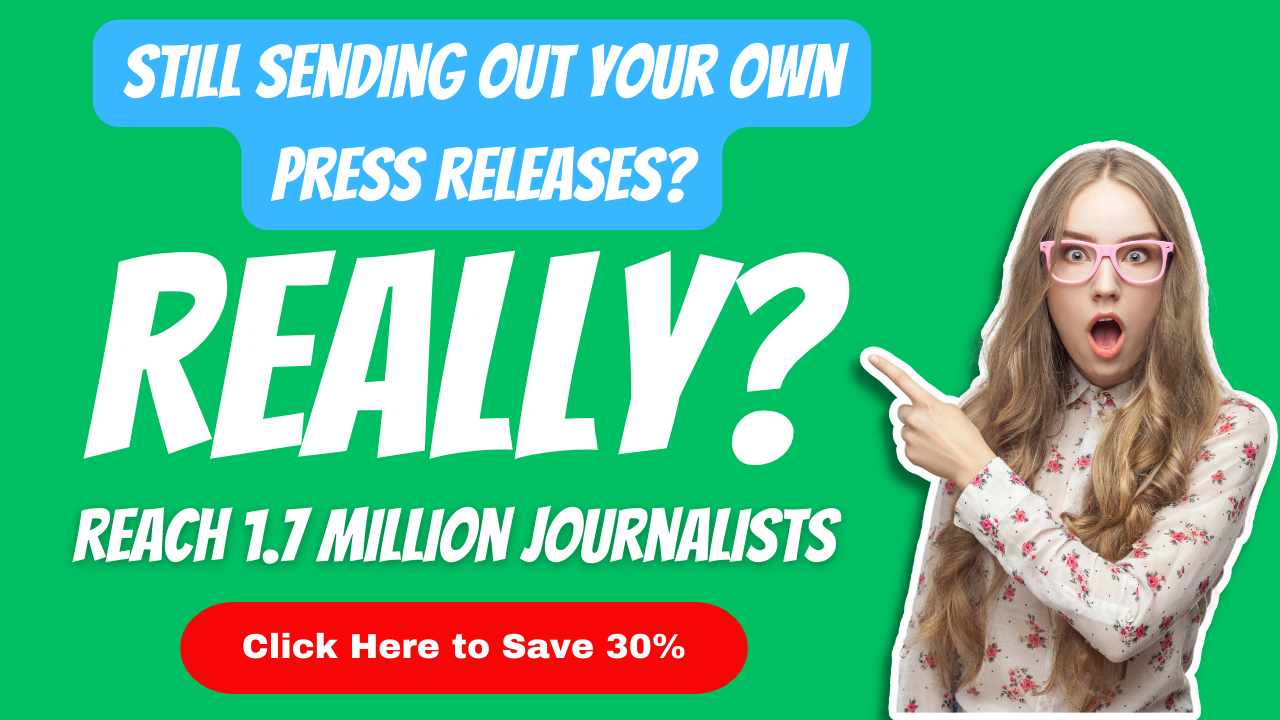
There is no better way to shine the spotlight on your company than through an event. Getting together influential people in a room and networking offers opportunities like no other.
But don’t let all that event planning fall flat with a half-empty room. Use publicity to make your event the success story you envisaged.
That starts with your press release. Here is how to create the perfect press release format for events.
The Headline
Right at the top of your event press release template will be your headline. It should be concise. Aim for around six to twelve words. But it must also be descriptive.
Remember that it’s there to capture the attention of media and readers, so it needs to strike a balance between being informative and exciting.
It should provide enough information that people who don’t delve further into the press release understand the essence of this event.
Try to mix in some words that help evoke the excitement you want people to feel when they read this headline. Here are a few examples:
- Award-winning
- Premiere
- Exclusive
- First-ever
- Unveiling
- Debut
- Annual
- Prestigious
Remember that the headline sets the tone for all that follows. So, keep with the writing style of the rest of the press release to target the right audience.
An Optional Subheading
It’s hard to convey all your event messages in a short headline, which is why subheadings exist. These add detail and context and provide more hints that act as ways to persuade the reader to explore the rest of the press release.
The subheading goes underneath the headline for easy scanning. You have a slightly longer word count than your headline, so aim for between ten and twenty words.
There are a few angles you can take with this subheadline. You can provide key details about the event, like the time, location, and date.
Or you can use the subheading to highlight some of the event’s more unique or exciting aspects. Remember that the subheading is a bridge that links your headline with the rest of your press release.
Date and Venue
The next part of your event’s press release is the event details. Here, you’ll summarize the date and time. You’ll also note the venue and location, including city and state.
Make the formatting of this information prominent to help it stand out, like adding it in bold font. It means readers can refer to the press release anytime and quickly get the event details they need without searching the entire document.
Be specific on the date and include the day of the week and the year. That helps avoid confusion if someone stumbles on your press release a year or two from now.
It’s also worth adding the country if you have an international audience.
The Introductory Paragraph
The first paragraph sets the scene for your event. It’s an overview that gives much of the most relevant information in your press release. It answers the who, what, where, why, and when.
It talks about the organizers behind the event and the nature of the event itself. That will also hint at some of the event’s most exciting highlights and activities.
The section on where the event is held will add specific details about the location. However, you may have already covered this in the previous section. If so, you can add more detail here, like how to get to the event.
The same is true for the time and location. You can add more detail here or rely on your press release’s date and time section.
Perhaps the most crucial part of the introduction is explaining the motivation for the event. It helps the reader better understand why the event is intriguing and newsworthy.
The Remaining Paragraphs
After the introductory paragraphs, you can flesh out some of the details. Here is how you should format the remaining paragraphs.
Short and Concise
Format the rest of the paragraphs to make them easily scannable. Keep paragraphs short and add bullet points or lists where relevant.
Provide Background Information
After reading the introductory paragraph, your most engaged readers will have some follow-up questions about your event. These remaining paragraphs give you a chance to answer those questions.
Use it to provide more background, such as whether the event has happened before and who will attend.
Talk About the Objectives
Every event should have a goal. This section is your chance to talk about your objectives. Make this fun, engaging, and full of passion. People should read it and understand why this event is important to you and others.
Add Credibility
Provide information that will add credibility to your event. For example, you could talk about keynote speakers, celebrities, and high-profile guests. Perhaps your event has won an award in the past.
If it has a notable sponsorship arrangement, you can mention that here. It may also be a charity event. If it is, you can use this space to talk more about the charity and why you support it.
Add Uniqueness
You want your event press release to stand out. Look at your arrangements and note your event’s most exciting and unique aspect. Use your remaining paragraphs to mention this and why it makes your event different.
Add Quotes
Some well-placed quotes will add authority and help create a more readable format for your press release.
Make sure these quotes stand out from the rest of the paragraph. When writing the quote’s source, their role or job title is also worth mentioning.
Add Your Photo
Successful events always have visual appeal. When adding a photo to your press release, choose a picture that does justice to how your event will look.
If you haven’t run the event before and therefore don’t have pictures, you could use a mockup design of the event’s appearance. Alternatively, you can use the photo to show some well-known attendees.
If your event is about something visual – like art – you could use the image to display some of the best art that people can see at the event.
Good photos in an event press release tend to stand out so that they stop people in their tracks when they scroll a page online. Therefore, keep this in mind when choosing yours.
The Boilerplate
A boilerplate is an easily scannable description of the company or person behind an event. Use a concise format with bold text to help this stand out in your press release.
It should have summary information on the organizer’s name and company name. It should include the company’s background and key achievements. You might also want to add a mission statement if you have one.
The boilerplate is your opportunity to showcase your authority as a brand. So, make it look impressive.
Add a Bold Call-to-Action
Don’t forget the reason for doing a press release for your event.
You want people to buy tickets and your event to be a sell-out success. So, you have a strong call to action that gets as many people as possible to register for your event after they see the press release.
Good calls to action speak one-on-one to the reader and are easy to follow. So ditch the subtle hints and be direct.
Tell readers how they will miss out if they don’t act immediately. For example, you could mention that tickets are limited on a first-come, first-served basis.
The Event Summary
At the end of your press release, it’s a good idea to summarize all that came before it. But don’t paraphrase your press release. Highlight the essential points.
It means the reader can take away the information they need without having to return to the beginning of the press release. Format it with bold and bullet points to make it stand out.
The most essential details must include the date, time, and location.
You should also add information about the organizer and some of the key highlights or attendees. If tickets aren’t on sale yet, use this space to provide the date for when they will be available to order.
Contact Information
You’ll need to supply contact information in your press release. That allows the media to follow up with your press release with further questions.
Ensure you include your primary contact’s name, email address, and telephone number. If you have a PR agency, you may want to use their contact details here.
Include a job title, too, so that people know more about the contact. It’s also helpful to use this section to say whether or not you welcome interviews or more in-depth queries from journalists.
A Professional Press Release Format for Events
Take the time to get the press release format for events perfect.
It looks professional and will have more of an impact on your recipient. So, you are more likely to boost your reach when distributing it to the media.
At eReleases, we have access to one of the best media databases around, which gives you the best chance of your event’s press release succeeding. Head here to begin your order.
